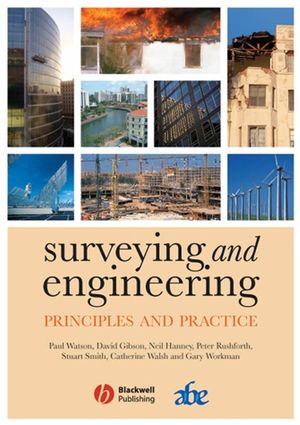Surveying and Engineering: Principles and PracticeISBN: 978-1-4051-5923-4
Paperback
304 pages
April 2008, Wiley-Blackwell
 |
||||||
Principles and Practice of Management.
Management of Health and Safety at Work.
Building Adaptation.
Fire Safety.
Advanced Building Control.
Sustainable Construction.
CHAPTER 2 PRINCIPLES AND PRACTICE OF MANAGEMENT.
Introduction.
Project Management Life Cycle.
Project Management Control.
Cost Planning and Control.
Cost Control Procedures.
Value Management Practice: Value Engineering.
Time Management Control.
Programme Management.
Risk Management.
Likelihood Impact Scoring Technique (LIST).
Risk Response for Monitoring Control.
Post Completion Review.
Project Management Functions.
Controlling.
Planning.
Forecasting.
Organising.
Motivation.
Co-ordinating.
Communication.
Project Stakeholders and Clients.
Leadership.
Management Styles.
Group Analysis.
Culture.
Building the Team.
Influencing and Persuading the Team.
RADAR.
Single, Double and Triple Loop Learning.
Networks.
Summary.
Further Reading.
Appendices.
References.
Case Study on web address……………… as supporting reading.
Appendices.
Appendix one: Example of Cost Report Check List.
Appendix two: Example of a Project Change Proposal Form.
Appendix three: Example of a Change Control Register.
Appendix four: Example of a Consultant Performance Monitoring Checklist.
Appendix five: Example of a Risk Log Book.
Appendix six: Example of a Project Review Form.
CHAPTER 3 MANAGEMENT OF HEALTH AND SAFETY AT WORK.
Overview of the Construction Industry.
Cost to industry.
Accident Record/Injuries.
Standards of Duty.
Enforcement of health and safety provisions.
Statutes & Delegated Legislation.
Health & Safety at Work Act 1974.
Management of Health & Safety at Work Regulations 1999.
Construction Design and Management Regulations 2006.
Schedule 2 - Welfare Facilities.
Schedule 3 - Regulation 20 (Construction Regulations).
Work at Height Regulations 2005.
Personal Protective Equipment Regulations 1992.
Reporting of Injuries, Diseases and Dangerous Occurrence Regulations 1995.
Risk Management.
Summary.
Further Reading.
Appendices.
References.
Appendices.
Appendix A: Main Duty Holder under CDM.
Appendix B: Health & Safety Checklist/Risk Assessment.
CHAPTER 4 BUILDING ADAPTATION.
Introduction.
Problems.
House Prices.
Population Size and Demographics.
Density of Population.
Brownfield Development.
Environmental Impact of Buildings.
Value of Construction Work.
Building Adaptation.
Building Adaptation - Issues for Consideration.
Choices for the Building Owner.
Feasibility Study.
Whole Life Costing.
Life Cycle Assessment.
The Cost of Going Green.
Summary.
Further Reading.
References
CHAPTER 5 FIRE SAFETY
Introduction.
Fire Science.
Behaviour of Fuels in a Fire.
Fire Properties.
Factors Determining Fire Severity.
Internal Fire Spread.
Fire Growth.
Surface Spread of Flame.
Fire Resistance.
External Fire Spread.
Means of Escape in Case of Fire.
Travel Distances.
Alternative Exit Requirements.
Number of Exits Required.
Inner Rooms.
Protected Corridors.
Protected Stairs.
Evacuation of the Building.
Progressive Horizontal Evacuation.
Phased Evacuation.
Means of Escape for Disabled People.
Physical Measures.
Fire Alarm Systems.
Fire Safety Engineering.
How Does Fire Safety Engineering fit in with the Building Regulations?.
Problems with Fire Safety Engineering.
Benefits of Fire Safety Engineering.
Problems with the Approved Document or ‘Code Based’ Approach.
Benefits of the Approved Document or ‘Code Based’ Approach.
Fire Safety Legislation.
The Regulatory Reform (Fire Safety) Order 2005.
Fire Risk Assessment.
Factors that can Reduce the Risk of Fire Occurring or Becoming Unmanageable.
General Considerations.
Human Behaviour in Fire.
Sleeping Risk.
Number of Occupants.
Mobility.
Familiarity.
Response to Fire.
Escape Behaviour.
Detection and Alarm Systems.
Voice Alarms.
Selection of a Fire Alarm System.
Detectors.
Smoke Detectors.
Heat Detectors.
Flame Detectors.
Beam Detectors.
Fire Safety Management.
Toxic Effects of Fire.
Summary.
Further Reading.
References.
CHAPTER 6 ADVANCED BUILDING CONTROL.
Introduction.
The Building Control Process.
Current Building Regulations and Administrative Processes.
The Building Act 1984.
The Building Regulations 2000.
Procedural Requirements.
The Role of the Building Control Professional.
Other Duties and Responsibilities.
Building Regulations – Application and Use.
Amendments to the Building Regulations Since 2001.
The Two Systems of Building Control.
Licensing Legislation.
Historical Development of Licensing.
Licensing of Public Entertainments.
The Licensing Act 2003.
Provision of Regulated Entertainment.
Personal Licence.
Premises Licence.
Temporary Events.
Summary.
Further Reading.
CHAPTER 7 Sustainable Construction.
Introduction.
Sustainable Development.
The Economics of Environmental Problems.
Sustainability Issues.
Global Problems.
Climate Change.
Ozone Layer Depletion.
Resource Depletion.
Population Growth.
Regional Problems.
Acid Rain.
Flooding.
Local Problems.
The Environmental Impacts of Construction.
Legislative, Regulation & Management Issues.
Environmental Impact Assessment.
Building Control Regulations.
Environmental Management Systems.
Sustainable Construction.
Reducing Energy Consumption.
Reducing the Impact of Energy Production.
Solar Energy.
Wind Power.
Hydro Power.
Biomass Energy.
Heat Pumps.
Combined Heat & Power.
Water Issues.
Water Conservation.
Sustainable Urban Drainage Systems.
Green Roofs.
Summary.
Further Reading.
References



